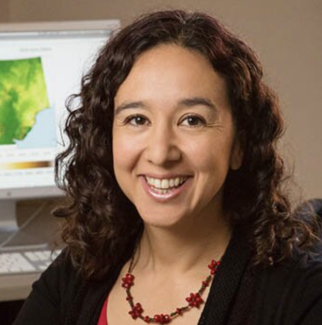Event
"Beating" of the Amazonian Hydroclimate and Possible Future Changes
Dr. Francina Dominguez - University of Illinois

Francina Dominguez is an Associate Professor in the Dept of Atmospheric Sciences at Univ of Illinois and a hydroclimatologist focused on the interactions between the land and atmosphere.
ABSTRACT: Many studies have shown that climatologically, between 20 and 40% of the precipitation that falls over the Amazon basin comes from transpiration from the dense canopy and evaporation from soils within the forest itself. However, estimating the local terrestrial contribution of moisture at an intra-daily timescale is not easily done with existing methods. Water vapor tracers embedded within the Weather Research and Forecasting (WRF) atmospheric model allow us to “tag” the moisture that originates from the Amazonian basin and track it in space and time as it moves through the atmosphere and eventually rains out of the atmospheric column. This tool allows us to analyze detailed processes that occur at much smaller spatial and temporal scales than previously studied. Analysis of the results led us to the discovery of a characteristic “beating” of the atmospheric moisture of Amazonian origin. Water vapor originating from Amazonian ET ebbs and flows with a diurnal pattern. While the timescale of total water vapor is dominated by the annual cycle, while the tracer water vapor (the water vapor of Amazonian origin) doesn’t show a predominant annual signal but a very important diurnal cycle. The characteristic timescales of evapotranspiration, precipitation and moisture transport by winds drive the variability of tracer water vapor. Conceptually, tracer water in the air column increases as evapotranspired moisture accumulates during the day, then some of this water is rained out through convective precipitation and another part of it is “swept away” by strong nocturnal winds. The cycle then repeats the following day. These processes come together to form a “beating” pattern that characterizes atmospheric moisture of the Amazon forest. In the latter part of the talk I will step away from the diurnal timescale and use WRF with tracers to analyze the possible impacts of future Amazonian deforestation on hydroclimate patterns over the continent. Our results show that deforestation leads to changes that are seasonally very different. During the dry season, deforestation results in increased albedo and less available net radiation. This change, together with reduced leaf area, results in decreased evapotranspiration (ET), less atmospheric moisture of Amazonian origin, and an increase in temperature. However, we find no changes in precipitation over the basin. Conversely, during the wet season, surface winds increase significantly due to decreased surface roughness. Vapor transport increases throughout the deforested region and leads to an increase in easterly moisture export, and significant decrease in precipitation within the deforested regions of Eastern Amazon. Contrary to expectations, the moisture tracers in WRF show no evidence that precipitation decreases are due to recycling or changes in stability.
If interested in attending this seminar session, please contact Nicholas Crivaro at ncrivaro@sas.upenn.edu for login details.
